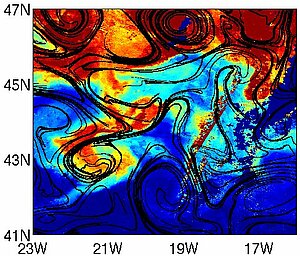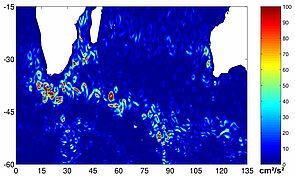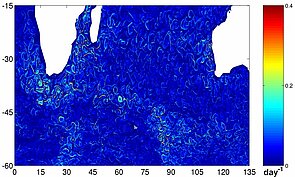Thread-like structures extracted from altimetry
Image of the Month - October 2008
Observations of drifting buoys at the ocean surface and very high resolution remote sensing data show the ubiquitous presence of long, thin thread-like structures -- filaments. These structures are about 1 to 50 km wide, with much longer lengths. They have a strong impact on transport, upwelling/downwelling, as well as on mixing. Direct observation of filaments is possible due to the growing availability of high-resolution datasets but is limited to campaign or regional coverage. However, filaments can be detected indirectly from both the spatial and the temporal variability of altimetry. For that, a mathematical technique is used that enable to reconstruct the "history" of water masses transported by geostrophic currents. This allows to compute structures of a few kilometers from the coarser grain altimetry data (30-100 km), and this over all the oceans. This information can be used to better know mixing, locate mesoscale/submesoscale fronts, and validate the spatiotemporal variability of a velocity field.
Regions of strong filamentation are mainly associated with regions of high kinetic energy. Some significant differences arise, however, due to the fact that filaments dynamics depend on the temporal variability of mesoscale turbulence.
The future altimetry project including altimeter-interferometers should improve the altimetry dataset resolution up to about 15 km. In the meantime, and for even smaller scales, mathematical techniques could help study the finer structures of ocean dynamics.
Eddy kinetic energy and Lyapunov exponents. The Eddy kinetic energy unveils the instantaneous position of mesoscale eddies and is limited to the altimetry resolution. Lyapunov exponents show the location of tracer filaments induced by the mesoscale eddies. By combining both spatial and temporal information, Lyapunov exponents are not limited to the altimetry resolution. (Credits Institut des Systèmes complexes, Paris Île-de-France (ISC-PIF))
See also:
- Data: Data Unification and Altimeter Combination System (Duacs)
- Applications: Mesoscale circulation
References:
- Lehahn Y., d'Ovidio, F., Y. Lehahn, F. d'Ovidio, M. Levy, E. Heifetz, Stirring of the Northeast Atlantic spring bloom: a Lagrangian analysis based on multi-satellite data, J. Geophys. Res., 112, C08005 (2007).
- d'Ovidio F., Levy M., Madec G., A global climatology of surface filaments computed from altimetry, in preparation.
- Contact: F. d'Ovidio, Institut des Systèmes complexes, Paris Île-de-France (ISC-PIF)







